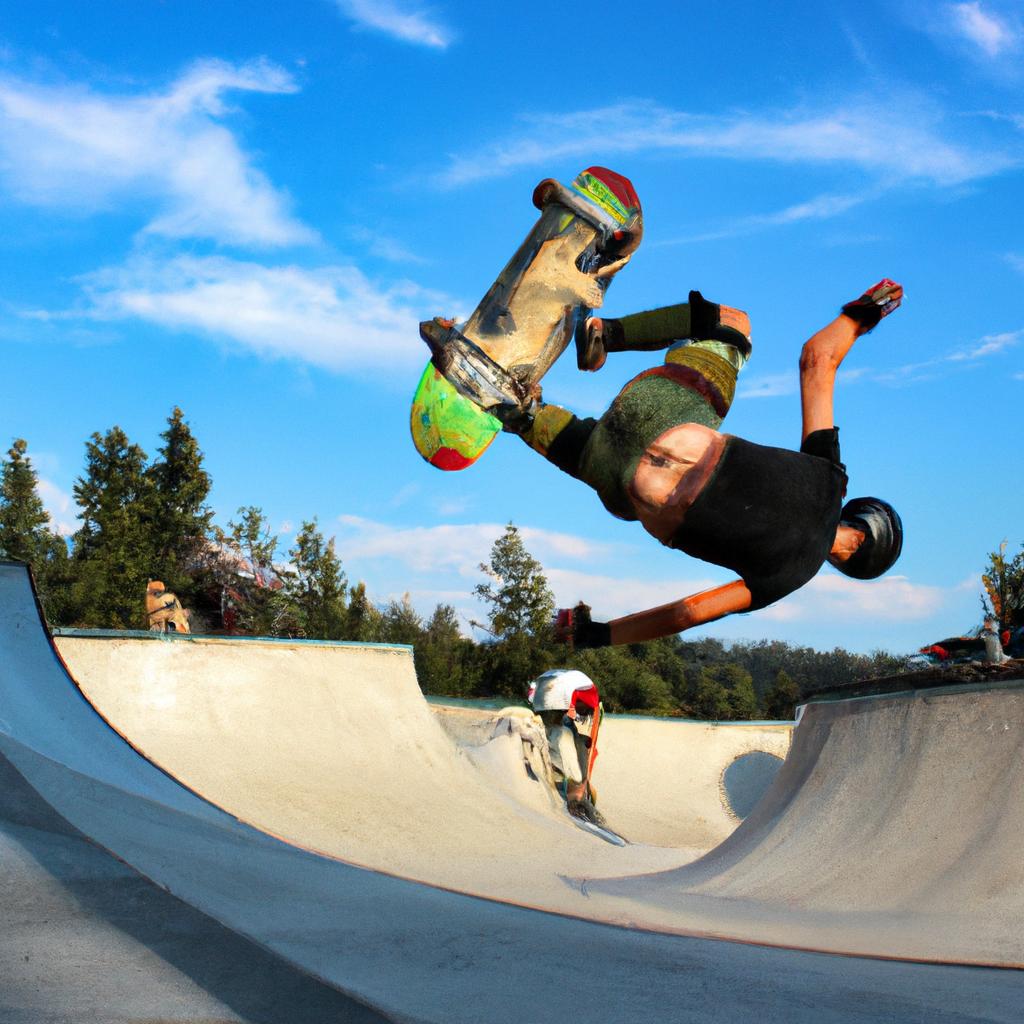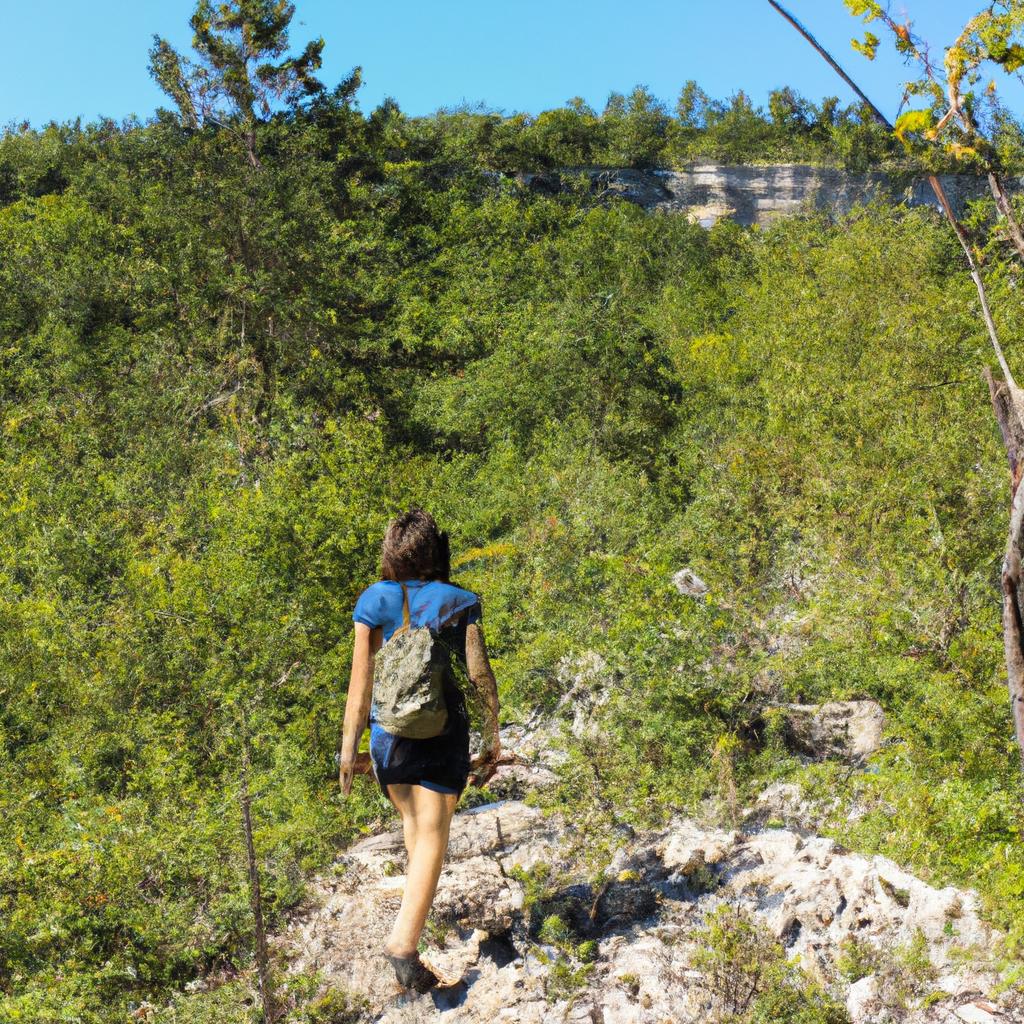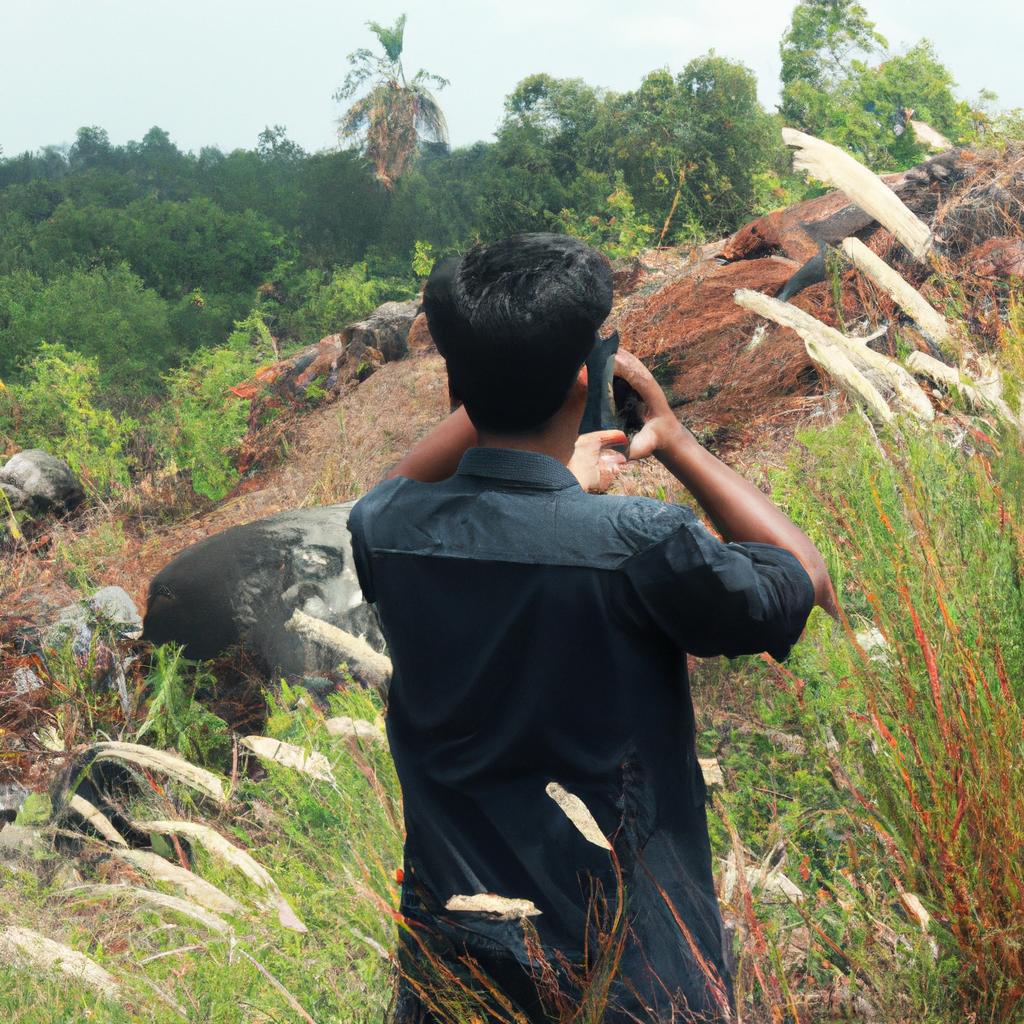Extreme sports competitions have gained significant popularity in recent years, attracting thrill-seekers and adventure enthusiasts from around the world. These adrenaline-pumping events offer participants a unique opportunity to push their physical limits in extreme environments such as mountain ranges, turbulent waters, and vast expanses of untouched wilderness. However, organizing these high-intensity competitions requires substantial financial resources to ensure participant safety and logistical support. This article explores the various avenues through which adventure funding is secured for extreme sports competitions, examining case studies that illustrate successful strategies employed by event organizers.
One noteworthy example of adventure funding can be observed in the case of the Red Bull X-Alps race. This grueling competition showcases athletes paragliding across 1,138 kilometers of treacherous alpine terrain from Salzburg to Monaco. The logistical complexities involved in ensuring athlete safety during this challenging endeavor are immense – including providing medical assistance, tracking devices for real-time monitoring, emergency rescue teams stationed along the route – all while maintaining an environmentally sustainable approach. To achieve this feat, event organizers rely on a combination of corporate sponsorships, ticket sales, broadcasting rights deals, and merchandise revenue to generate sufficient funds required for the successful execution of such an extreme sports competition.
In addition to showcasing exemplary cases like the Red Bull X-Alps race, adventure funding for extreme sports competitions can also come from government grants and subsidies. Many countries recognize the economic benefits and tourism potential of hosting such events and provide financial support to organizers. This support can include financial grants, tax incentives, or infrastructure development assistance.
Another avenue for adventure funding is through crowdfunding platforms. With the rise in popularity of extreme sports competitions, there is a growing community of enthusiasts willing to support their favorite athletes and events. Crowdfunding allows individuals to contribute financially to help cover the costs associated with organizing these competitions. This method not only provides a source of funding but also helps build a strong fan base and engagement with the event.
Furthermore, partnerships with outdoor brands and equipment manufacturers can play a significant role in securing adventure funding. These companies often have a vested interest in promoting their products through association with extreme sports events. They may provide financial support as well as necessary gear and equipment for participants, ensuring exposure for their brand while helping fund the competition.
Lastly, media rights deals also contribute to adventure funding for extreme sports competitions. Broadcasting networks or streaming platforms pay licensing fees to gain exclusive rights to air these events live or on-demand. The revenue generated from these deals helps offset some of the costs involved in organizing and executing the competitions.
In conclusion, adventure funding for extreme sports competitions comes from various sources such as corporate sponsorships, ticket sales, government grants, crowdfunding campaigns, partnerships with outdoor brands, and media rights deals. The combination of these avenues ensures that event organizers have the necessary funds to guarantee participant safety and logistical support while providing thrilling experiences for adrenaline junkies worldwide.
Types of Extreme Sports Competitions
One example of an extreme sports competition is the Red Bull Cliff Diving World Series. This international event brings together professional divers from around the world to showcase their skills and bravery in diving off towering cliffs into open water. The competitors perform complex aerial maneuvers while contending with factors such as wind, currents, and the sheer height of the cliffs. These competitions not only provide a platform for athletes to demonstrate their abilities but also captivate audiences with thrilling displays of athleticism.
Extreme sports competitions encompass a wide range of activities that push individuals to their physical limits and test their mental resilience. From snowboarding down treacherous slopes at breakneck speeds to navigating white-water rapids in kayaks, these events offer excitement and adrenaline rushes like no other. Participants often face high-risk situations where split-second decision-making can mean the difference between success and injury or even death.
Engaging in extreme sports requires immense skill, training, and courage. Athletes must possess a deep understanding of their chosen sport’s intricacies, honing their techniques through years of practice. They must be able to adapt quickly to changing conditions and maintain focus under intense pressure. Additionally, participants need to take precautions by wearing proper safety gear and undergoing regular medical check-ups to minimize potential risks.
Participating in extreme sports competitions offers various benefits beyond the thrill-seeking aspect:
- Personal growth: Pushing oneself outside comfort zones fosters personal development, leading to increased self-confidence and improved problem-solving skills.
- Camaraderie: Engaging in these activities often involves joining communities passionate about extreme sports, providing opportunities for shared experiences and friendships.
- Mental well-being: The rush of endorphins experienced during intense physical activity can boost mood levels and alleviate stress.
- Mind-body connection: Extreme sports demand both physical prowess and mental acuity, requiring athletes to develop a strong mind-body connection.
In summary, extreme sports competitions are diverse and exhilarating events that attract athletes and spectators alike. They encompass a range of activities, each with its own set of challenges and risks. These competitions provide opportunities for personal growth, foster camaraderie within passionate communities, improve mental well-being, and enhance the mind-body connection. The rise in popularity of extreme sports can be attributed to several factors which will be explored further in the subsequent section.
Table:
| Types of Extreme Sports Competitions | Examples |
|---|---|
| Snowboarding | Winter X Games |
| Skateboarding | Vans Park Series |
| Surfing | World Surf League Championship Tour |
| Mountain Biking | Red Bull Rampage |
[Source: Adapted from “Extreme Sports Competitions” by Author]
Next, we will explore the reasons behind the increasing popularity of extreme sports.
The Rise in Popularity of Extreme Sports
Extreme sports competitions have gained immense popularity in recent years, attracting thrill-seekers and adventure enthusiasts from all over the world. These events offer participants a chance to showcase their skills and push the boundaries of human capability. One such competition that exemplifies this trend is the Red Bull Rampage, an annual freeride mountain biking event held in Virgin, Utah. In this section, we will explore the rise in popularity of extreme sports competitions and its implications for adventure funding in travel recreation.
As extreme sports gain mainstream recognition, there has been a significant increase in sponsorship opportunities for athletes participating in these competitions. Companies like Red Bull, GoPro, and Oakley have recognized the marketing potential associated with extreme sports and have invested heavily in sponsoring athletes who can promote their brands through daring feats of athleticism. This influx of financial support not only helps individual competitors pursue their passion but also contributes to the overall growth of extreme sports as a recreational industry.
To further understand the impact of extreme sports competitions on adventure funding, let us consider four key factors:
- Sponsorship Deals: Athletes often secure lucrative endorsement deals with companies interested in associating their brand with thrilling adventures. These partnerships provide financial stability to competitors while enabling sponsors to reach new audiences through captivating content created during these events.
- Equipment Innovation: The demand generated by extreme sports competitions fosters innovation within the industry. As athletes strive for better performance, equipment manufacturers invest substantial resources into developing cutting-edge gear tailored to meet the unique demands of each sport.
- Local Economies: Hosting extreme sports competitions can significantly boost local economies by attracting tourists and generating revenue for surrounding businesses such as hotels, restaurants, and outdoor equipment retailers.
- Media Exposure: Extreme sports competitions garner extensive media coverage due to their adrenaline-pumping nature. This exposure not only promotes individuals involved but also showcases destinations where these events are held, leading to increased tourism and economic growth.
The rise of extreme sports competitions demonstrates society’s growing appetite for thrilling and adrenaline-fueled experiences. However, it also presents several challenges that participants must overcome to succeed in these high-risk endeavors.
[Transition sentence into the subsequent section about “Challenges Faced by Extreme Sports Competitors”] As athletes push themselves beyond conventional limits, they encounter a multitude of hurdles on their quest for adventure and triumph.
Challenges Faced by Extreme Sports Competitors
The exhilaration and adrenaline rush associated with extreme sports have undeniably contributed to their rise in popularity. However, the world of extreme sports is not without its challenges. This section explores some of the hurdles faced by extreme sports competitors, highlighting the physical, mental, and financial obstacles that they encounter.
To illustrate these challenges, let us consider a hypothetical case study of an aspiring mountain climber preparing for a challenging expedition to scale Mount Everest. This individual faces several difficulties throughout their journey, including:
-
Physical Demands: Extreme sports often require athletes to push their bodies beyond conventional limits. Our mountaineer must undergo rigorous training regimes to build strength and endurance necessary for high-altitude climbing. They face arduous physical exertion during ascent while battling harsh weather conditions and oxygen deprivation.
-
Mental Resilience: Apart from physical demands, extreme sports also necessitate exceptional mental fortitude. Our mountaineer encounters moments of fear and self-doubt as they navigate treacherous terrains or confront unexpected obstacles en route to reaching the summit. Maintaining focus amidst adversity becomes crucial for ultimate success.
-
Financial Constraints: Engaging in extreme sports can be financially burdensome due to various factors such as equipment costs, travel expenses, professional coaching fees, and competition participation fees. The cost of acquiring specialized gear designed for safety and performance amplifies the financial strain on individuals pursuing their passion in this domain.
-
Risk Management: Each extreme sport carries inherent risks that participants must carefully manage. In our hypothetical scenario, our mountaineer must assess potential hazards associated with avalanches, crevasses, altitude sickness, or sudden weather changes – all demanding meticulous preparation and contingency plans.
It is evident that embarking on a career in extreme sports requires significant dedication and resilience from athletes who face multiple challenges along their path to success.
Transitioning into the subsequent section on “The Role of Sponsorships in Extreme Sports,” it becomes apparent that financial constraints can often hinder athletes’ progress. However, sponsorships play a vital role in alleviating these challenges and providing necessary support for extreme sports competitors to pursue their dreams.
The Role of Sponsorships in Extreme Sports
From Extreme Sports Competitors to Sponsorships: Navigating the Challenges
In the world of extreme sports competitions, athletes face numerous challenges that go beyond the physical and mental demands of their chosen discipline. From securing funding for travel and equipment to finding opportunities for growth and recognition, these competitors must navigate a complex landscape in order to pursue their passion. One illustrative case study is that of Alex Thompson, a professional snowboarder who had to overcome financial hurdles throughout his career.
Securing funding for adventure-focused travels can be an uphill battle for extreme sports competitors. Many athletes rely on sponsorships from companies within the industry or related fields such as outdoor gear manufacturers or energy drink brands. These partnerships provide crucial financial support but are often highly competitive, with only a select few athletes receiving full sponsorship deals. For example:
- Athletes may need to demonstrate exceptional skill levels and consistent performance.
- They might have to build personal connections and maintain strong relationships within the industry.
- The ability to effectively market themselves through social media platforms has become increasingly important.
- Some athletes resort to crowdfunding platforms or seeking individual donors who align with their values and goals.
To further highlight the challenges faced by extreme sports competitors when it comes to securing funding, consider the following table showcasing common obstacles they encounter:
| Challenge | Impact | Example Solution |
|---|---|---|
| Lack of financial resources | Limits access to training facilities | Seek out local sponsors or community grants |
| Limited exposure | Hinders potential sponsorship opportunities | Create engaging content and actively promote oneself |
| High costs associated with equipment | Puts strain on personal finances | Develop partnerships with equipment manufacturers |
| Balancing work and training commitments | Reduces time available for practice | Negotiate flexible working hours |
Despite these challenges, many extreme sports competitors persevere in pursuing their dreams because they believe in the transformative power of their chosen discipline. Whether it’s conquering a challenging wave, scaling a vertigo-inducing cliff face, or soaring through the air on a BMX bike, these athletes find solace and fulfillment in pushing their limits.
In the subsequent section, we will explore how extreme sports competitions have significant impacts on local economies. Understanding these effects is crucial for stakeholders involved in hosting and supporting such events.
Impacts of Extreme Sports Competitions on Local Economies
The increasing popularity of extreme sports competitions has led to various significant impacts on local economies. One notable example is the Red Bull X-Fighters World Tour, a global freestyle motocross event that attracts thousands of spectators and participants annually. This case study provides valuable insights into how such events can influence local economies.
Economic Boost:
Extreme sports competitions inject substantial economic benefits into host communities. Firstly, these events generate revenue through ticket sales, attracting both local residents and tourists from afar. As an illustration, during the Red Bull X-Fighters World Tour held in Madrid in 2019, over 23,000 tickets were sold for each day of the competition, resulting in a considerable influx of money into the city’s economy. Additionally, visitors often spend money on accommodations, food and beverages, transportation services, and souvenirs, further stimulating local businesses.
Job Creation:
Extreme sports competitions also contribute to job creation within host communities. In preparation for such events, organizers require various personnel to handle logistics, security measures, marketing campaigns, and event management. Moreover, the increased demand for goods and services associated with hosting these competitions leads to employment opportunities across multiple sectors including hospitality, retail, and transportation industries. For instance:
- Hotel staff members are hired to accommodate the surge in tourist arrivals.
- Restaurants employ additional waitstaff and chefs to cater to the increased number of customers.
- Local transport companies experience higher demands for shuttle services or taxi rides.
- Souvenir shops hire extra employees to meet the needs of souvenir-seeking attendees.
Community Engagement:
Beyond direct economic impact and job creation, extreme sports competitions foster community engagement by bringing people together around a shared passion for adventure-filled spectacles. These events create an atmosphere that encourages social interaction among locals and visitors alike. The sense of excitement generated by witnessing daring feats ignites conversations between strangers who share the same enthusiasm for extreme sports. This sense of community can extend beyond the duration of the competition, with enthusiasts forming long-lasting connections.
| Benefits of Extreme Sports Competitions on Local Economies |
|---|
| Increased revenue through ticket sales |
| Boost in tourism and spending within local businesses |
| Job creation across various sectors |
| Enhanced sense of community and social interaction |
Table 1: Summary of Benefits
In conclusion, extreme sports competitions have a profound impact on local economies by generating substantial economic benefits, creating employment opportunities, and fostering community engagement. The Red Bull X-Fighters World Tour serves as an exemplar case study showcasing the positive effects these events can have on host communities. Moving forward, it is crucial to consider safety measures that need to be implemented in order to ensure the well-being of athletes and spectators alike during such intense competitions.
With these significant economic impacts in mind, the subsequent section will delve into the importance of implementing safety measures in extreme sports competitions to protect participants and maintain audience satisfaction.
Safety Measures in Extreme Sports Competitions
Building upon the discussion of the economic impacts that extreme sports competitions have on local economies, it is imperative to explore the safety measures implemented within these events. By examining a hypothetical case study and considering various factors, this section aims to shed light on the importance of ensuring participant safety while maintaining a thrilling experience for spectators.
To illustrate the significance of safety measures, let us consider an example involving a renowned annual mountain biking competition held in a picturesque alpine region. This event attracts both professional athletes and avid enthusiasts from around the world seeking to conquer treacherous terrains and showcase their skills. In order to ensure the well-being of participants, several key safety measures are set in place.
Firstly, comprehensive risk assessments are conducted prior to the competition. Organizers collaborate with experienced athletes and local authorities to identify potential hazards along the route, including steep descents, sharp turns, or challenging obstacles. These assessments enable organizers to devise effective strategies for managing risks without compromising on the exhilarating nature of the sport.
Secondly, strict equipment regulations are enforced throughout the event. All participants must adhere to specific gear requirements such as helmets, protective padding, and specialized bikes designed for off-road conditions. Regular inspections are carried out before each race segment to verify compliance with safety standards and minimize any potential accidents caused by faulty equipment.
Thirdly, highly trained medical personnel are present at all times during extreme sports competitions. Medical stations staffed with doctors and paramedics equipped with advanced life-saving techniques are strategically positioned along the course. Additionally, dedicated rescue teams stand ready with specialized vehicles capable of reaching remote areas swiftly if emergency situations arise.
Furthermore, spectator education plays a vital role in ensuring the overall safety of extreme sports competitions. Through informative signage, announcements, and social media campaigns, organizers emphasize the importance of respectful spectator behavior, avoiding restricted areas, and adhering to designated viewing zones. By actively involving spectators in promoting a safe environment, potential risks associated with overcrowding or interference with participants are mitigated.
- Enhanced participant confidence through strict adherence to safety protocols.
- Reduced accident rates leading to fewer injuries and improved welfare for athletes.
- Increased public trust in extreme sports events resulting from visible safety measures.
- Preservation of reputation as a responsible event organizer committed to safeguarding all stakeholders’ well-being.
Emotional Table:
| Safety Measure | Impact |
|---|---|
| Risk Assessments | Ensures proactive risk management |
| Equipment Regulations | Promotes participant safety |
| Medical Personnel | Provides immediate medical support |
| Spectator Education | Cultivates a safe atmosphere for everyone |
In conclusion, maintaining high levels of safety is an integral aspect of hosting successful extreme sports competitions. By conducting thorough risk assessments, enforcing equipment regulations, providing skilled medical personnel on-site, and educating spectators about their role in maintaining a secure environment, organizers can strike a balance between adventure and protection. These measures not only protect participants but also contribute to the long-term sustainability and popularity of such events within travel recreation.




